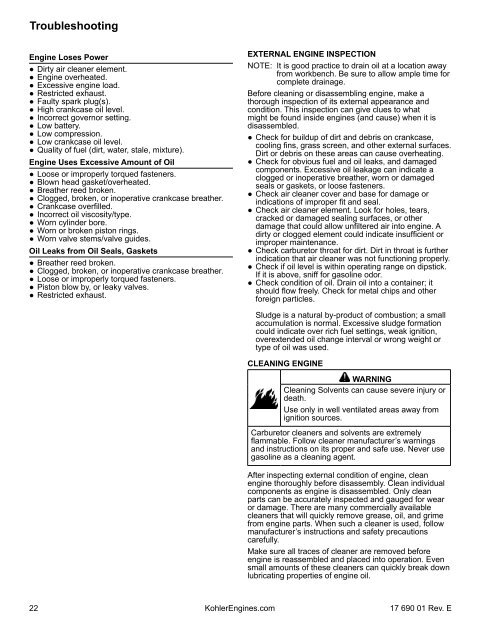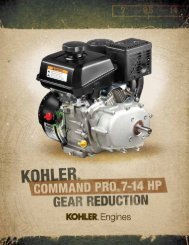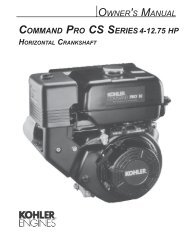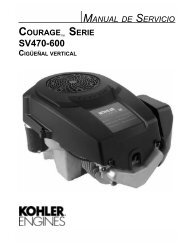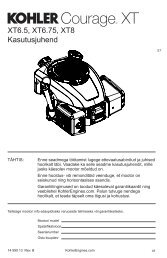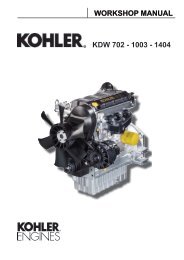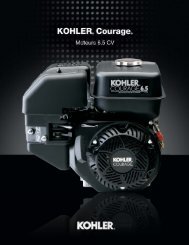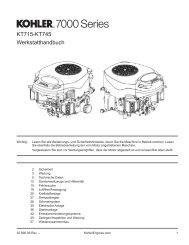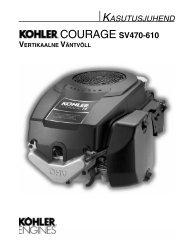CH260-CH440 Service Manual - Kohler Engines
CH260-CH440 Service Manual - Kohler Engines
CH260-CH440 Service Manual - Kohler Engines
Create successful ePaper yourself
Turn your PDF publications into a flip-book with our unique Google optimized e-Paper software.
TroubleshootingEngine Loses Power● Dirty air cleaner element.● Engine overheated.● Excessive engine load.● Restricted exhaust.● Faulty spark plug(s).● High crankcase oil level.● Incorrect governor setting.● Low battery.● Low compression.● Low crankcase oil level.● Quality of fuel (dirt, water, stale, mixture).Engine Uses Excessive Amount of Oil● Loose or improperly torqued fasteners.● Blown head gasket/overheated.● Breather reed broken.● Clogged, broken, or inoperative crankcase breather.● Crankcase overfilled.● Incorrect oil viscosity/type.● Worn cylinder bore.● Worn or broken piston rings.● Worn valve stems/valve guides.Oil Leaks from Oil Seals, Gaskets● Breather reed broken.● Clogged, broken, or inoperative crankcase breather.● Loose or improperly torqued fasteners.● Piston blow by, or leaky valves.● Restricted exhaust.EXTERNAL ENGINE INSPECTIONNOTE: It is good practice to drain oil at a location awayfrom workbench. Be sure to allow ample time forcomplete drainage.Before cleaning or disassembling engine, make athorough inspection of its external appearance andcondition. This inspection can give clues to whatmight be found inside engines (and cause) when it isdisassembled.● Check for buildup of dirt and debris on crankcase,cooling fins, grass screen, and other external surfaces.Dirt or debris on these areas can cause overheating.● Check for obvious fuel and oil leaks, and damagedcomponents. Excessive oil leakage can indicate aclogged or inoperative breather, worn or damagedseals or gaskets, or loose fasteners.● Check air cleaner cover and base for damage orindications of improper fit and seal.● Check air cleaner element. Look for holes, tears,cracked or damaged sealing surfaces, or otherdamage that could allow unfiltered air into engine. Adirty or clogged element could indicate insufficient orimproper maintenance.● Check carburetor throat for dirt. Dirt in throat is furtherindication that air cleaner was not functioning properly.● Check if oil level is within operating range on dipstick.If it is above, sniff for gasoline odor.● Check condition of oil. Drain oil into a container; itshould flow freely. Check for metal chips and otherforeign particles.Sludge is a natural by-product of combustion; a smallaccumulation is normal. Excessive sludge formationcould indicate over rich fuel settings, weak ignition,overextended oil change interval or wrong weight ortype of oil was used.CLEANING ENGINEWARNINGCleaning Solvents can cause severe injury ordeath.Use only in well ventilated areas away fromignition sources.Carburetor cleaners and solvents are extremelyflammable. Follow cleaner manufacturer’s warningsand instructions on its proper and safe use. Never usegasoline as a cleaning agent.After inspecting external condition of engine, cleanengine thoroughly before disassembly. Clean individualcomponents as engine is disassembled. Only cleanparts can be accurately inspected and gauged for wearor damage. There are many commercially availablecleaners that will quickly remove grease, oil, and grimefrom engine parts. When such a cleaner is used, followmanufacturer’s instructions and safety precautionscarefully.Make sure all traces of cleaner are removed beforeengine is reassembled and placed into operation. Evensmall amounts of these cleaners can quickly break downlubricating properties of engine oil.22 <strong>Kohler</strong><strong>Engines</strong>.com17 690 01 Rev. E


